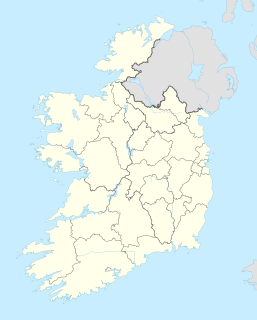 W
WBansha is a village in County Tipperary in Ireland. The village is part of the parish of "Bansha and Kilmoyler" in the Roman Catholic Archdiocese of Cashel and Emly. It is in the historical barony of Clanwilliam. Bansha is co-extensive with the pre-Reformation parish of Templeneiry of which the townland name of Templenahurney is thought to be a corruption. While the village is the focal point of the area, there is also an outlying hamlet in the parish, located at Rossadrehid where a rural creamery once serviced the dairy industry.
 W
WThe Battle of Callann was fought in August 1261 between the Hiberno-Normans, under John FitzGerald, and three Gaelic clans: MacCarthy, who held the Kingdom of Desmond, and their kinsmen, the O'Sullivans, and the O'Donoghues under Fínghin Mac Carthaigh, King of Desmond, ancestor of the MacCarthy Reagh dynasty. It took place in the townland of Callann or Collon near modern-day Kilgarvan, County Kerry. MacCarthaigh was victorious.
 W
WThe battle of Knocknaclashy, took place in County Cork in southern Ireland in 1651. In it, an Irish Confederate force led by Donagh MacCarthy, Viscount Muskerry was defeated by an English Parliamentarian force under Roger Boyle, 1st Earl of Orrery. It was the final pitched battle of the Irish Confederate Wars and one of the last of the Wars of the Three Kingdoms.
 W
WBlarney Castle is a medieval stronghold in Blarney, near Cork, Ireland. Though earlier fortifications were built on the same spot, the current keep was built by the MacCarthy of Muskerry dynasty, a cadet branch of the Kings of Desmond, and dates from 1446. The Blarney Stone is among the machicolations of the castle.
 W
WThe Blarney Stone is a block of Carboniferous limestone built into the battlements of Blarney Castle, Blarney, about 8 kilometres from Cork, Ireland. According to legend, kissing the stone endows the kisser with the gift of the gab. The stone was set into a tower of the castle in 1446. The castle is a popular tourist site in Ireland, attracting visitors from all over the world to kiss the stone and tour the castle and its gardens.
 W
WThe Book of Lismore, also known as the Book of Mac Carthaigh Riabhach, is a late fifteenth-century Gaelic manuscript that was created at Kilbrittain, Co. Cork, Ireland, for Fínghean Mac Carthaigh, Lord of Carbery (1478–1505). Defective at beginning and end, 198 leaves survive today, containing a miscellany of religious and secular texts written entirely in Irish.
 W
WJames de Barry, 17th Baron Barry and 4th Viscount Buttevant, was the son of Richard de Barry, of Rathbarry in Barry Roe, and Isabel FitzGerald, a daughter of Sir James FitzGerald of Leixlip, who was a son of Gerald FitzGerald, 8th Earl of Kildare. His father Richard was a son of James de Barry, Lord of Ibane, and Elane MacCarthy of Muskerry.
 W
WCarbery, or the Barony of Carbery, was once the largest barony in Ireland, and essentially a small, semi-independent kingdom on the southwestern coast of Munster, in what is now County Cork, from its founding in the 1230s by Donal Gott MacCarthy to its gradual decline in the late 16th and early 17th centuries. His descendants, the MacCarthy Reagh dynasty, were its ruling family. The kingdom officially ended in 1606 when Donal of the Pipes, 17th Prince of Carbery chose to surrender his territories to the Crown of England; but his descendants maintained their position in Carbery until the Cromwellian confiscations, following their participation in the Irish Rebellion of 1641.
 W
WCarrigadrohid is a townland and village in the parish of Aghinagh, County Cork, Ireland. It is situated on the north bank of the River Lee, with the nearby village of Canovee to the south. Carrigadrohid is part of the Cork North-West.
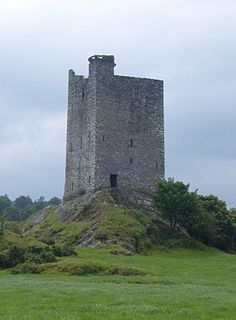 W
WCarrigaphooca Castle, is a ruined five storey rectangular tower house situated on a steep-sided rock overlooking the River Sullane. It is located 6 km west of Macroom, County Cork, Ireland, in an area once known as Gleann na n-Dearg. The tower dominates the landscape of Lissacresig (Fairyland) in Clondrohid, and Lower Shanballyshane, in Kilnamartyra. Carrigaphooca is made of sandstone and limestone and was built as a defensive tower by MacCarthy clan member Donal MacCarthy of Drishane c. 1336-51.
 W
WCarrigrohane Castle is located in the village of Carrigrohane, barony of Barretts in County Cork, Ireland. It is situated on a rocky cliff-edge which overlooks the River Lee.
 W
WCastle Salem is a fortified house near Rosscarbery, in County Cork, Ireland. The house was home to the Morris family from around 1660 until the early 1800s, and was bought in 1895 by the Daly family, descendants of whom now run it as a guest house.
 W
WCallaghan MacCarty, 3rd Earl of Clancarty was born in Ireland, the second son of Donough MacCarty, 1st Earl of Clancarty. Callaghan was destined for a Catholic religious career and entered a seminary or monastery in France where his family was in exile during Cromwell's rule. However, when his elder brother died in the Battle of Lowestoft, and the 2nd Earl, his nephew, died in infancy, he unexpectedly left his religious institution, returned to Ireland, became a Protestant, and assumed the title. Just before his death he converted back to Catholicism.
 W
WDonough MacCarthy, 1st Earl of Clancarty, 2nd Viscount Muskerry (1594–1665), was a leader of the Irish Confederation. He led the Confederates' Munster army during most of the Irish Confederate Wars and the Cromwellian conquest of Ireland. He belonged to the moderate faction, which wanted to collaborate with the royalists against the Commonwealth and the Covenanters. He was one of the last to surrender. In 1658, in exile, Charles II created him Earl of Clancarty. He recovered his lands at the Restoration.
 W
WThe Kingdom of Desmond was a historic kingdom in southwestern Ireland. It was founded in 1118 by king Tadhg Mac Cárthaigh, when the Treaty of Glanmire formally divided the Kingdom of Munster into Desmond and Thomond. It comprised all of what is now County Cork and most of County Kerry. Desmond was ruled by the Mac Cárthaigh (MacCarthy) dynasty. Other clans within the kingdom included the O'Sullivans and O'Donovans. Following the Norman invasion of Ireland in the late 12th century, the eastern half of Desmond was conquered by the Anglo-Normans and became the Earldom of Desmond, ruled by the FitzGeralds and Fitzmaurices. The king of Desmond, Diarmaid Mac Cárthaigh, submitted to Henry II of England, but the western half of Desmond lived on as a semi-independent Gaelic kingdom. It was often at war with the Anglo-Normans. Fínghin Mac Carthaigh's victory over the Anglo-Normans at the Battle of Callann (1261) helped preserve Desmond's independence. The kings of Desmond founded sites such as Blarney Castle, Ballycarbery Castle, Muckross Abbey and Kilcrea Friary. Following the Nine Years' War of the 1590s, Desmond became part of the Kingdom of Ireland.
 W
WDonal na Pipi MacCarthy Reagh was the 17th Prince of Carbery. from 1593 to 1606, when he surrendered the principality to the English Crown under the policy of Surrender and Regrant. He belonged to the MacCarthy Reagh dynasty as a son of Cormac na Haoine, the 13th Prince of Carbery. His epithet "of the Pipes" originates from when several pipes of wine washed up on the beach at Burren, which was traditionally believed to be a sign of good fortune for him.
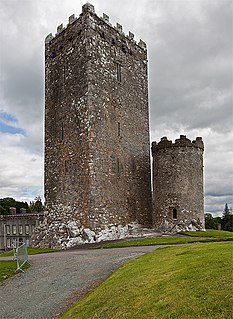 W
WDrishane Castle is a MacCarthy tower house and National Monument located in County Cork, Ireland. It is located 2.2 km (1.4 mi) northeast of Millstreet, on the south bank of the Munster Blackwater.
 W
WEarl of Clancarty is a title that has been created twice in the Peerage of Ireland.
 W
WKilbrittain or Killbrittain is the name of a village, townland and parish in County Cork, Ireland. The village lies about 5 miles (8.0 km) southwest of Bandon, and near Clonakilty and Kinsale. The coastal route around the edge of the parish is the R600 road. The village itself is around 1 mile (1.6 km) inland from the coast.
 W
WKilcrea Friary is a ruined medieval abbey located near Ovens, County Cork, Ireland. Both the friary and Kilcrea Castle, located in ruin to the west, were built by Observant Franciscans in the mid 15th century under the invitation of Cormac Láidir MacCarthy, Lord of Muskerry, as protection from English troops.
 W
WGerald FitzGerald, 8th Earl of Kildare KG, known variously as "Garret the Great" or "The Great Earl", was Ireland's premier peer. He served as Lord Deputy of Ireland from 1477 to 1494, and from 1496 onwards. His power was so great that he was called "the uncrowned King of Ireland".
 W
WThe Lordship of Coshmaing is an historic honorific title associated with the Gaelic nobility of Ireland. The title was created in the 14th century when the then King of Desmond, granted an appanage to one of his sons. As with other such titles in Ireland, it no-longer has any recognition under the law, and has not been used for several hundred years.
 W
WThe Gaelic-Irish Lordship of Molahiffe was created in the 14th century by Eóghan (Owen) Mór MacCarthy, Lord of Coshmaing, as a grant to his son, Donal. Molahiffe Castle was also the seat of The Paramount Lordship of Cosmaigne. The Gaelic title, Lord (Tiarna/Baron) of Molahiffe, should not be confused with the Baronetcy of Molahiffe, which was an English title held by some of the Browne family after they took possession of former MacCarthy lands at the beginning of the seventeenth century. Alternate spellings of Molahiffe include "Mullahiffe," and, "Moylahiffe."
 W
WThe Mac Cárthaigh Riabhach dynasty are a branch of the MacCarthy dynasty, Kings of Desmond, deriving from the Eóganacht Chaisil sept.
 W
WFinghin MacCarthy, also known as Fineen of Ringrone, was King of Desmond from 1251 to his death in 1261, shortly after his famous victory over John FitzGerald, 1st Baron Desmond at the Battle of Callann. He was the son of Donal Gott MacCarthy, King of Desmond and founder of the MacCarthy Reagh dynasty, Princes of Carbery, and for that reason is considered to belong to them.
 W
WMacCarthy, also spelled Macarthy, McCarthy or McCarty, is a Celtic/Gaelic Irish clan originating from Munster, an area they ruled during the Middle Ages. It was divided into several great branches; the MacCarthy Reagh, MacCarthy of Muskerry, and MacCarthy of Duhallow dynasties were the three most important of these, after the central or MacCarthy Mór line.
 W
WCormac na Haoine (1490–1567) was the 13th Prince of Carbery from 1531–1567. He belonged to the MacCarthy Reagh dynasty.
 W
WOwen MacCarthy Reagh (1520–1594) was the 16th Prince of Carbery from 1576 to 1593. He belonged to the MacCarthy Reagh dynasty. Owen was commonly referred to as "Sir" Owen MacCarthy (McCartie) in the English court records.
 W
WTeige-an-Duna MacCarthy, Lord of Glean-na-Chroim, was the last hereditary Prince of the Dunmanway branch of the MacCarthy Reagh dynasty of Carbery "who exercised the rights of his position." He was Prince from 1618 to 1648, dying the following year on 24 May 1649. He was also known as Teige the Hospicious for his great hospitality, while his epithet an Duna means "of the Fortress".
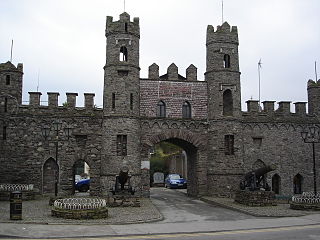 W
WMacroom is a market town in County Cork, Ireland which formed in the valley of the River Sullane, about halfway between Cork city and Killarney. Its Irish Gaelic may translate as "meeting place of followers of the god Crom" or "crooked oak", the latter a reference to a large oak tree that apparently grew in the town-square during the reign of King John. Its population has grown and receded over the centuries as it went through periods of war, famine and workhouses, forced emigration and intermittent prosperity. The 2016 census recorded an urban population of 3,765 people. Macroom is part of the Cork North-West.
 W
WMangerton or Mangerton Mountain, at 838 metres (2,749 ft), is the 19th-highest peak in Ireland on the Arderin list, and the 26th–highest mountain according to the Vandeleur-Lynam list. Mangerton is the tallest mountain in the Mangerton Mountain Group, also called the Mangerton Mountains or the Mountains of East Kerry, a range that includes five other major mountains that have a height above 2,000 feet (610 m). Mangerton's western slopes lie within the Killarney National Park. On Mangerton's north-western face lies a deep corrie lake called the Devil's Punchbowl, which is a popular scenic destination for hill walkers; although the mountain is often overlooked by walkers due to the proximity of its more scenic and accessible neighbour, Torc Mountain. The far northern slopes of Mangerton was the site of an important 13th-century battle between the Mac Cárthaigh, and the FitzGeralds, known as the "Tooreencormick battle site".
 W
WJustin McCarthy, Viscount Mountcashel, PC (Ire), was a Jacobite general in the Williamite War in Ireland and a personal friend of James II. He commanded Irish Army troops during the conflict, enjoying initial success when he seized Bandon in County Cork in 1689. However, he was defeated and captured at the Battle of Newtownbutler on the same year. He then led an Irish Brigade overseas for service in the French Army of Louis XIV. He died in French exile.
 W
WMoyvane is a small village in County Kerry in the south west of Ireland. It is situated off the N69 road between Listowel to the South-West and Tarbert to the North. The village of Knockanure lies to the immediate South. The parish in which the village is located is now also known as the "Parish of Moyvane". It was originally called the parish of Murhur, this was part of the ancient "Barony of Iraghticonnor".
 W
WCharles MacCarty, Viscount Muskerry was the heir apparent to Donough MacCarty, 1st Earl of Clancarty. He led a battalion at the Battle of the Dunes but was killed at the age of 31 in the Battle of Lowestoft, a sea-fight against the Dutch, and never succeeded to the earldom. His Irish first name was Cormac.
 W
WThe Rock of Cashel, also known as Cashel of the Kings and St. Patrick's Rock, is a historic site located at Cashel, County Tipperary, Ireland.
 W
WRoss Castle is a 15th-century tower house and keep on the edge of Lough Leane, in Killarney National Park, County Kerry, Ireland. It is the ancestral home of the Chiefs of the Clan O'Donoghue, later associated with the Brownes of Killarney.
 W
WThe Sliocht Cormaic of Dunguile, otherwise known as the MacCarthys of Srugrena Abbey, or the Srugrena sept, as well as the Trant McCarthys, are a sept of the MacCarthy Mór dynasty, the Kings of Desmond. They are descendants of a younger son, Cormac of Dunguile, of Tadhg na Mainistreach Mac Carthaigh Mór, King of Desmond. The line of the later kings of Desmond, to Donal IX MacCarthy Mór has long been extinct.
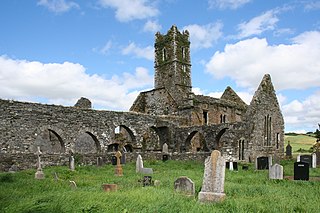 W
WTimoleague is a village in the eastern division of Carbery East in County Cork, Ireland. Located along Ireland's southern coast between Kinsale and Clonakilty. Nearby is the village of Courtmacsherry. It is about 17 km (11 mi) south of Bandon and 48 km (30 mi) from Cork on the R600 coastal road.